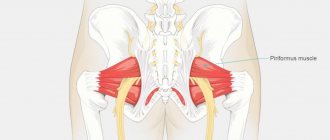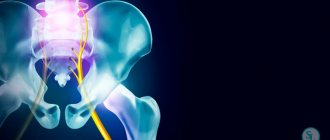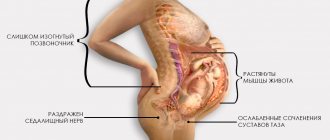Why does pathology occur?
Doctors consider primary and secondary neuropathy. The primary cause is injuries, infectious diseases and hypothermia. The list of reasons that can cause a secondary type of illness is much more extensive. These include:
- disc displacement;
- neoplasms of any nature;
- osteochondrosis;
- protrusion;
- osteophytes;
- spasmodic muscles;
- curvature of the ridge;
- tunnel syndrome;
- intervertebral hernia;
- post-injection suppuration.
Symptoms and diagnosis of sciatica
Various signs indicating lumbosacral nauralgia:
- Pain in the area of the sciatic nerve. Moreover, pain can appear only on one side of the body, and on the other there will be numbness, alternating with tingling. However, pain can occur in both legs at the same time.
- At the initial stage of sciatica, pain is mild. They intensify during physical activity, and they also worsen if the patient begins to cough, sneeze heavily or laugh. In these cases, the pain worsens in the lumbar region.
- There is a decrease in the mobility of the joints of the feet and knees, discomfort occurs when lifting the straight leg upward, and neurological reflexes weaken.
- As the disease progresses, the pain intensifies, especially at night. During such exacerbations, patients wake up from pain, it hampers movement and does not allow them to move.
- In advanced forms of the disease, the patient has difficulty finding a position in which he feels more or less comfortable - often the pain does not allow him to stand, sit, walk, or lie down.
A neurologist diagnoses sciatica of the sciatic nerve during a general examination of the patient, palpation, testing for neurological reflexes and analyzing the patient’s complaints. A biochemical blood test, a series of X-rays taken in different projections, or magnetic resonance imaging can confirm the diagnosis and establish the degree of progression of the disease.
Symptoms of inflammation of the sciatic nerve
Pain, which can even occur due to lifting a heavy bag or hypothermia, night attacks are the main indicator of sciatica. In addition to the sharp shooting pain syndrome, doctors advise paying attention to:
- “pins and needles” and numbness from the buttocks and below;
- constipation, urinary incontinence;
- weakness and gradual muscle atrophy, limping.
When a person moves or stands for a long time, pain is more disturbing. During attacks, redness of the skin, swelling, chills, and sweating are quite possible. At first, the pain syndrome is not very expressive, but gradually becomes so strong that there is a danger of loss of consciousness. It almost hurts for a person to breathe. If the disease is not treated, the entire leg will suffer: it will become cold, bending and unbending it will be problematic, and then the ability to move the foot and toes will be lost.
Diagnostics
An examination to refute or confirm the doctor’s suspicions of sciatica is a necessary step. Based on the results of the survey and examination, it is impossible to say for sure that you have been struck down by this particular disease. After you come to the medical facility, the doctor will talk with you and, depending on the specific case, may prescribe:
- X-ray;
- CT;
- MRI;
- electroneuromyography.
It is worth understanding that it is almost impossible to independently recognize sciatica, even with the most characteristic symptoms, and prescribe treatment for this disease at home. To establish an accurate diagnosis and proper treatment, you need to see a doctor and undergo diagnostics.
Pinching symptoms
Doctors consider several syndromes that indicate that the patient has a pinched nerve.
- Lesera – straight leg does not rise;
- Sikara – pain intensifies if a person bends the foot;
- landing - it is impossible to take a sitting position yourself.
It hurts to walk and squat, but if you lie down or sit with your legs spread wide apart, it goes away. Signs of inflammation and pinching of the sciatic nerve are quite expressive, but they can still be confused with other diseases:
- spondylitis;
- myeloma;
- ankylosing spondylitis;
- phlebothrombosis;
- arterial insufficiency.
Treatment methods
Unfortunately, it is impossible to cure sciatica in any one way. This disease is quite serious, and in order to get rid of it, you will need to take medications, apply ointments, do therapeutic exercises, attend massages and undergo physiotherapy.
Drug therapy
In general, the composition of medications for the treatment of sciatica is quite complex and includes:
- anti-inflammatory and painkillers;
- local anesthetics and anti-inflammatory drugs (ointments);
- muscle relaxants;
- vitamins and minerals;
- blockade (if the pain is unbearable).
Drug therapy is usually used in acute conditions, when it is necessary to relieve inflammation and eliminate pain. After the pain subsides, you can attend a massage, do physical therapy, etc.
Massage and physiotherapy
A visit to a massage therapist allows you to quickly cope with the disease; Sometimes massage can be useful in the acute stage of the disease. Massage helps distract a person from pain, improves blood flow and supplies nerve roots with nutrition, and also eliminates muscle hypertonicity and speeds up the outflow of lymph. Among physiotherapeutic agents, electrophoresis, UHF, laser therapy, and magnetic therapy are usually prescribed. These procedures speed up the healing process and increase the effectiveness of medications taken.
Therapeutic exercise and gymnastics
Exercises for the treatment of sciatica (inflammation of the sciatic nerve), which can be performed at home, will be very useful at the stage of subside of the pathological process. Naturally, you won’t be able to do physical exercise when every movement brings unimaginable pain, but after it decreases, it’s worth doing the exercises that your doctor will prescribe for you.
How to make a diagnosis
The disease is determined by a neurologist based on the results of motor tests that reveal the presence of the syndromes described above. But laboratory and instrumental studies are still necessary. As a rule, they are limited to x-rays in two planes. It may be necessary to obtain a more clear picture of the condition of the spine. In this case, a tomography will be prescribed. A radioisotope scan is done if a tumor is suspected.
When a person has inflammation of the sciatic nerve, treatment at home is not always acceptable, because the disease can manifest itself in such a serious form that the patient is prescribed bed rest in a hospital setting. Nerve-related illnesses must be taken seriously or you may lose your ability to move.
An immediate visit to a doctor is necessary in the following cases:
- severe numbness that prevents you from moving;
- increased body temperature;
- transfer of pain to other locations;
- incontinence of metabolic products;
- swelling in the lower part of the ridge.
Symptoms and signs of the disease
The most common manifestation of the disease is pain. Pain can be determined by the following characteristics:
- The nature of the pain syndrome - the pain can be burning, shooting, so acute that people describe it as a dagger pierced into the spine.
- Localization of pain - pain runs along the spine in the lumbar region, spreads to the buttocks, to the back of the thigh, into the hole under the knee, down the lower leg and can even reach the fingertips.
- The strength of the pain syndrome - as a rule, with inflammation of the sciatic nerve, it varies. Sometimes the pain is weak and practically not felt, in other cases it confines the person to the bed, since every movement and standing position causes very severe pain.
- Duration - pain can be constant or appear in the form of attacks, which depends on the stage of the disease and the causes that caused it.
- Symmetry - usually the pain appears on one side, only in rare cases it affects both the left and right sides of the back and legs.
If you are wondering what sciatica is (inflammation of the sciatic nerve), how to treat this disease at home, then know that your first action should be to contact a neurologist
. The stage of prescribing treatment tactics is preceded by establishing the causes of sciatica, as well as confirming the diagnosis using diagnostic procedures.
How to treat inflammation of the sciatic nerve
Treatment measures are aimed at:
- relieving the patient of pain;
- improved sensitivity of the limbs;
- restoration of leg functionality.
To achieve this, they resort to methods of traditional and alternative medicine. Treatment begins with pain relief. Then physiotherapy, therapeutic exercises, and manual therapy come into play. In parallel, the rich experience of traditional medicine can be used.
Medicines prescribed for the treatment of sciatica include the following groups of drugs:
- non-steroidal;
- corticosteroids;
- vitamin complexes;
- biogenic stimulants;
- muscle relaxants;
- decongestants;
- angioprotectors.
External means are widely used - warming creams and ointments, which contain snake or bee venom, hot pepper, camphor, turpentine. Massage for inflammation of the sciatic nerve helps improve blood circulation and restore muscle tone.
A huge role in restoring leg functions belongs to physiotherapeutic procedures, for example, magnetic and laser therapy, electrophoresis, and dynamic current treatment. Various types of physical exercises, selected for a specific patient, reduce muscle spasms and strengthen the body.
To heal at home, you will have to be patient, since sciatica responds better to the efforts of professionals. There are cases when the disease started precisely because of insufficiently active therapeutic measures. The more complex the case, the more effective drugs have to be prescribed. So, if non-steroidal drugs do not help, although a person takes them for a long time, steroid drugs are prescribed, which have significant side effects.
In many clinics, in addition to the main treatment, patients undergo courses:
- acupuncture;
- ozone therapy;
- herbal medicine;
- cupping and vacuum massage;
- stone therapy;
- treatment with leeches;
- cauterizations.
Many recipes for compresses, lotions, and tinctures have been developed. But it is better not to try them on yourself without consulting your doctor. The doctor knows where and how they can help or harm. Therefore, it is necessary to consult.
Spa and hydrotherapy is an excellent way to improve overall health and regulate various pathologies, including inflammation of the sciatic nerve, the symptoms and treatment of which, due to their diversity and complexity, require long-term and careful attention.
If therapeutic methods do not produce results, the nerve has to be decompressed. This is done surgically.
It is not enough to know how to treat sciatica, that is, inflammation of the sciatic nerve. It is necessary to be aware of how to protect yourself from such a serious, life-spoiling and health-robbing illness.
Among the preventive measures, doctors recommend the following:
- do not freeze;
- strengthen immunity;
- lift weights correctly;
- develop posture;
- sleep on hard mattresses;
- beware of sudden movements.
A healthy body significantly increases the likelihood that the spine will work correctly, and the nerve roots will avoid inflammation and will not be pinched.
We specialize in the treatment of the musculoskeletal system, even in severe stages of disease. We have been helping thousands of patients avoid surgery for 10 years!
Our doctors
This is the strongest team of experts who teach at the RUDN Department. We are the clinical base of leading universities, where the best doctors in Moscow, unique specialists from Russia and abroad are trained.
Causes
Such an unpleasant condition as inflammation of the sciatic nerve can be caused by a variety of factors. Among them:
- Herniated disc - when a bulge appears, it begins to put pressure on nearby tissues, depending on the location of the bulge, the sciatic nerve may also suffer.
- Spinal cord stenosis in the lumbar spine, which provokes tissue compression.
- Spondylolisthesis - symptoms of sciatica occur due to the displacement of one vertebra relative to the others.
- Hypothermia of the body, provoking an inflammatory process.
- The appearance of osteophytes - bone growths caused by osteoarthritis or osteochondrosis.
- Spinal instability – the vertebral bodies become abnormally mobile and periodically shift during movements.
Determining the symptoms and prescribing treatment for sciatica may also be necessary due to the fact that tumors of various nature have formed near the vertebrae; The disease can also be a consequence of poisoning the body with various substances, including alcohol and other toxins.
Hypothermia
Hypothermia significantly reduces the body's defenses and can cause a large number of diseases, including sciatica. Cold can provoke inflammation and the addition of infectious processes to it. As a rule, almost half of patients are diagnosed with sciatica precisely because of hypothermia, but there are other reasons that cause inflammation of the sciatic nerve, and cold in this case is only a catalyst.
Traumatic injuries
Most often, sciatica develops in young people who, due to their age, are very mobile. Fragments of the vertebrae and displacement of their bodies can cause inflammation of the sciatic nerve.
Changing the shape of the vertebrae
The development of scoliosis and other changes in the shape of the vertebrae is another cause of pinched nerve tissue. Based on this, inflammation of the sciatic nerve will develop, which will cause severe discomfort to the person, and only a doctor will help get rid of it.
Causes of sciatica
As we have already noted, sciatica can be caused by other pathologies that appear in the body. Most often these are the following phenomena:
- Displacement of the intervertebral disc, bone growths on the spine (osteophytes), narrowing of the spinal canal. All this causes pinching of the sciatic nerve.
- Intervertebral hernia.
- Injuries and overuse.
- Infectious diseases.
- Hypothermia.
- The emergence of neoplasms.
Sciatica can also provoke toxic poisoning (alcohol, mercury, lead, etc.). Sometimes the sciatic nerve becomes inflamed during pregnancy, gynecological diseases, and arthritis.










